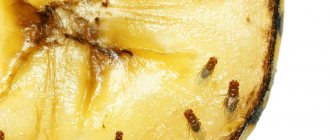general description
Ficus elastica robusta belongs to the tall trees of the mulberry genus.
Scientific name: Robusta. Distributed in Indonesia, India, Nepal, China, Burma.
It is the tallest representative of ficus.
The largest Robusta trees reach more than 60 meters. The diameter of the trunk can be 2 meters. In indoor conditions, the trunk can branch greatly.
The plant forms a large number of aerial roots, which overtake the soil over time. The thickness of such roots is not suitable for a banyan tree. The crown of a ficus of this genus does not grow in breadth. Elastica differs from other representatives by its wide glossy wavy leaves. The leaves reach more than 20 centimeters in width and about 40 centimeters in length. New leaves can curl into small covers, which fly off after a while. The edges of the leaves are turned inward. The surface of newly emerging leaves has a red-emerald tint.
The surface of old leaves is dark, emerald green. The leaf blade is round-oval in shape with a thin, sharp tip. The central vein is well expressed, wide, emerald. The petiole is short and light.
What Ficus elastica brings to the house: signs and superstitions
The luxurious leaves of Ficus Elastica are able to absorb various harmful compounds from the air and process them into amino acids and sugar, which makes this plant a welcome guest in any home.
In Eastern countries, Ficus Rubber is held in high esteem. For example, in India it is customary to give it to childless families, since it is believed that it brings the desired addition. According to Feng Shui and Ayurveda, Ficus Elastica brings calm and tranquility to the home, drives away anxiety and anger, and also helps cleanse the space of bad energy.
In Russia, the attitude towards this ficus is rather ambiguous. At one time, the plant was incredibly popular, but then it gained fame as a “husband’s herb.” If in the East Ficus elastica is considered almost a symbol of family happiness, then in Russia it is not customary to give it to unmarried girls, since there is a belief that she will never get married.
Despite all the prejudices, Ficus elastica still remains one of the most popular indoor plants, which alone can decorate a spacious room and create a bright natural accent in the interior.
Home care
After purchase, the flower can take a long time to get used to the atmosphere of the house. Transferring a plant to another climate is fraught with a stressful situation. After purchasing, the plants should be placed in a well-lit room without direct sunlight.
Ficus elastica grows well in partial shade next to a balcony or windows. Can tolerate northern exposures well.
Watering
Watering should be regular and plentiful.
The plant does not tolerate excessive flooding with water. For such ficuses, a good drainage system is specially made from pebbles or composite.
Constant overflows lead to acidification of the soil and rotting of the root system. The soil should dry out well between waterings. Without dehydration, the flower may begin to lose leaves.
Bloom
The flowering of ficus Robusta indoors is almost imperceptible compared to the size of a natural tree. Seconia fruits and amber-emerald inflorescences are miniature, reaching no more than 1 centimeter in diameter.
Crown formation
Ficus Elastica does not require crown formation. Such trees are allowed to grow freely even at home. To actively develop the side stems of an adult flower, you can cut off the top.
The soil
Robusta is not picky about soil. The soil should be nutritious with plenty of salts and minerals. It is better to choose purchased breathable soil. Planting is done in large containers. Due to the large growth of the plant, replanting is carried out annually. Young trees require fertilizing the soil with complex fertilizers.
Nutrient solutions with a large amount of nitrogen are well suited for this procedure. It is difficult to replant adult plants. Therefore, for such trees, the top layer of soil is replaced.
How to form a crown
Ficus grows only upward, and most gardeners like lush plants. The best time to prune plants is spring. At this time, sap flow increases and favorable conditions for growth are created.
Pruning rules for crown formation:
- The top of the ficus, the length of which has reached 70 cm, is cut off. The cutting is placed in water so that it takes root. New shoots will grow from the cut trunk.
- In short plants, pinch the top; one shoot will sprout in this place.
- Bend the top down and tie it to the trunk. After a shoot appears from the upper bud, the crown is untied and released.
- A hole is pierced with a needle at 1/3 of the depth of the trunk. The operation begins from above, since the process grows only from the lower puncture. If you first pierce the bottom of the trunk, only one shoot will grow; sprouts will no longer appear from the upper punctures.
The juice that appears after pruning is removed with a damp cotton swab. A month after pruning, the soil in the ficus pot is fertilized.
Photo
In the photo there is a ficus "Robusta":
What problems may arise
Ficus Robusta has good immunity to diseases and parasites. But sometimes troubles cannot be avoided. You will need to reconsider the stages of plant care if you are faced with the phenomenon of yellowing of the foliage or its dropping. The tree may lack moisture, it may be located in a draft or suffer from direct sunlight. Brown wet spots on the surface of the leaves will tell you about overwatering. If a putrid smell emanates from the pot, the roots could begin to hurt due to excessive watering.
A plant can respond by falling leaves when it moves from its permanent place of residence to a new one. When the air in the room is dry, pests may appear - spider mites and scale insects. They live from the inside of the foliage in whole families. They feed on the sap of leaves, leaving behind an unpleasant sticky liquid. If there are still a few pests, wiping the surface of the leaves with a damp sponge may be enough. But most often treatment with modern insecticides is required.
Reproduction
Reproduction occurs by cuttings. You can use the stems after trimming the top crown. It is necessary to choose planting material with three leaves (internodes).
Rooting occurs in home greenhouses. They are created using plastic bottles or glass jars. The main thing is that such a container allows sunlight to pass through.
Temperature
Good growth of ficus occurs at temperatures from 18 to 25°C.
A shorter or longer interval has a negative effect on the plant.
Trimming
The rapid growth of ficus must be restrained by regularly cutting off the top. This measure helps to form a beautiful crown and rejuvenate the plant.
The procedure is carried out in early March, when the growing season begins. Rules:
- shoots are removed at a height of 3 to 5 leaf blades;
- thin branches are cut straight, thicker stems - at an angle;
- cut areas are treated with crushed activated carbon.
When removing shoots, stumps should not be left, so as not to provoke the development of fungal diseases.
If the ficus is not pruned, it will very quickly grow to the ceiling.
Benefits and harms
The branches of the plant secrete milky sap. It is excellent for extracting rubber.
Drops of snow-white, dense juice flow out when cutting the stems and leaves of the plant.
A curved cut is made on one of the branches under the bark. A container is placed at the wound site. To prevent the juice from coagulating, the incision is covered with a bandage pre-moistened with alcohol. Vinegar is added to the container and the resulting mixture is mixed well. The concentrate produces flakes, which are washed under running water and rolled into elongated strips.
Rubber is subjected to various tests, since it does not dissolve in water and does not swell during precipitation. Such rubber can be easily processed into rubber or glue. More than 60% natural rubber is used to make tires. Rubber production is practiced on a large scale in Thailand, Indonesia and Malaysia.
Diseases and pests
Ficus Elastica is almost not exposed to pests. Spider mites sometimes appear on the leaves of the flower. To combat this pest, the leaves of the plant are washed under running cold water, after covering the soil of the container. The leaves are wiped with wet napkins.
The main attention should be paid to the back side of the leaves, since this mite collects colonies and settles in areas inaccessible to the human eye.
After water treatments, the pest completely disappears. A plant can only get sick from unsystematic care. The most common manifestations are dropping leaves, changing their color and slowing the growth of the trunk. A plant can get sick from any stressful situation.
Ficuses get sick from excess or lack of sunlight, insufficient watering, winds, drafts, high room temperatures, and dry air. Sometimes diseases appear several months after uncomfortable conditions. Ficus Elastica rubbery Robusta responds well to fertilizing.
Can grow in partial shade on the gray side. The flowering of the plant is almost imperceptible. Under natural conditions, trees reach a height of 60 meters.
This amazing plant will help transform the atmosphere in the room and create coziness. On our portal we have prepared for you a number of articles about growing the following types of ficus: Abidjan, Tineke, Black Prince, Belize and Melanie.
Transfer
Replanting should be done as the flower grows, when the roots are visible on the surface of the soil. Rules:
- The next pot should be 2-4 cm larger in diameter than the previous container.
- Young ficus are replanted annually, flowers over 4 years old - once every 2 years.
- The root collar does not go deep into the soil.
Attention! Ficus purchased in a store must be replanted after a few days, when the plant acclimatizes to the new place.











